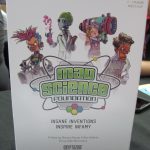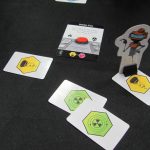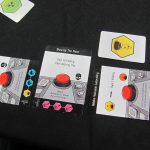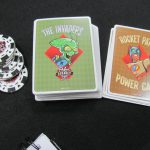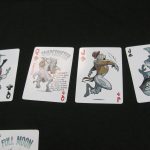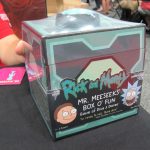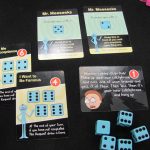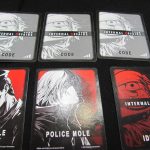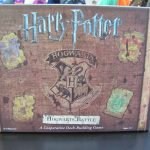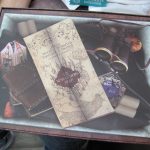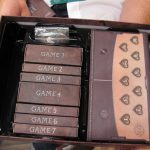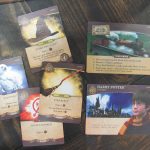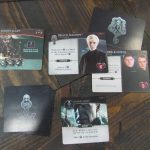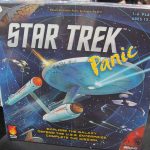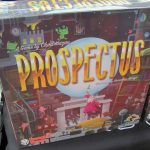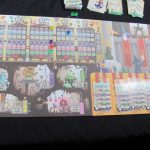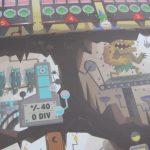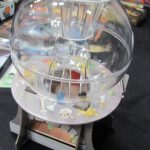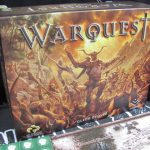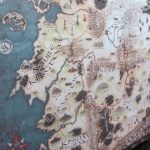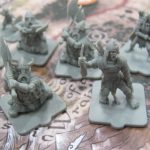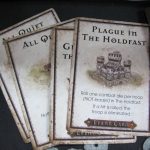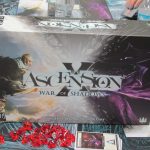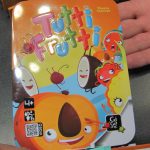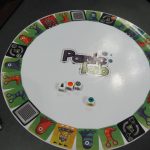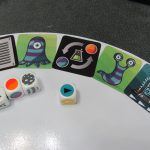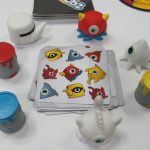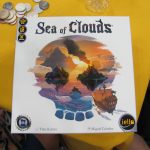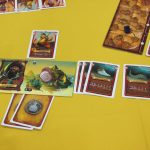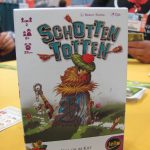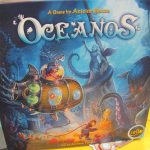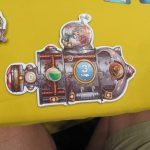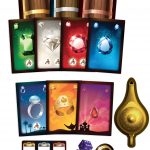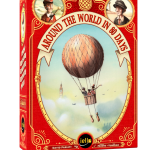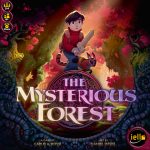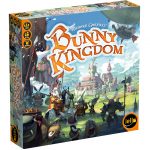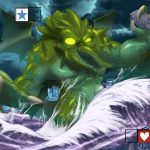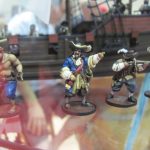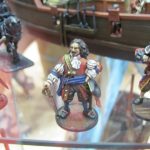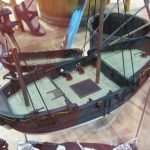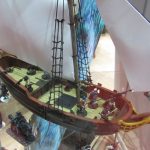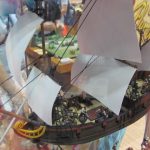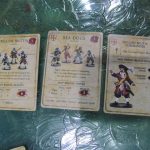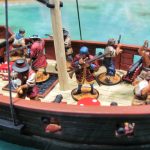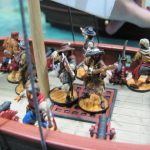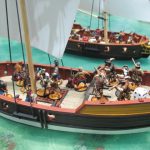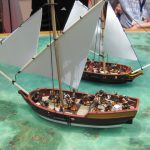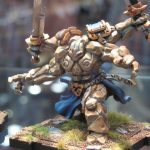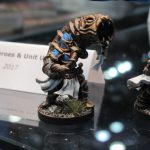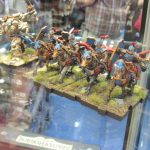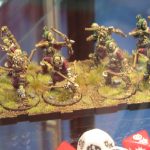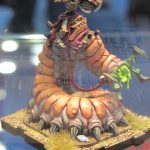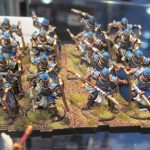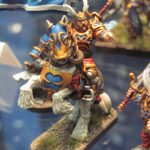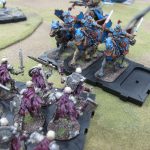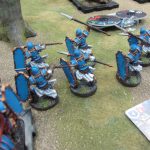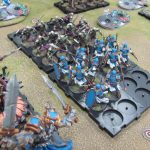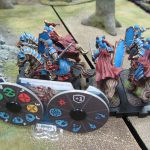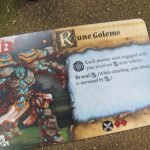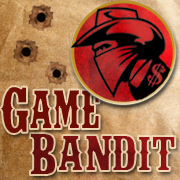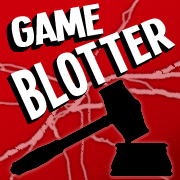 Gen Con continues to grow, expanding out of the Indiana Convention Center into the Lucas Oil Stadium, using the entire 92,000 square foot football field area for exhibits and game play space. Although unique attendees were down slightly last year when the convention began use of the football stadium, the number of daily attendees increased with more attendees present on multiple days. The 50th anniversary of the convention will see it expanded to the entire field level and two exhibit halls in the stadium. Located on the field will be an “homage construction” approximate-scale replica of the Lake Geneva Horticultural Hall where the first Gen Con took place.
Gen Con continues to grow, expanding out of the Indiana Convention Center into the Lucas Oil Stadium, using the entire 92,000 square foot football field area for exhibits and game play space. Although unique attendees were down slightly last year when the convention began use of the football stadium, the number of daily attendees increased with more attendees present on multiple days. The 50th anniversary of the convention will see it expanded to the entire field level and two exhibit halls in the stadium. Located on the field will be an “homage construction” approximate-scale replica of the Lake Geneva Horticultural Hall where the first Gen Con took place.
The convention space will use more than 750,000 square feet of the ICC, Lucas Oil Stadium, and the connector space. “It’s the most space ever booked for an Indianapolis connection,” writes the Indianapolis Business Journal. The financial impact of the convention on the city for last year’s convention was between $71 and $72 million dollars, according to Visit Indy, the city’s tourism board. With the increased space and the 50th anniversary celebration, the number of attendees and economical impact on the city is expected to grow.
Gen Con 2017 will be held in August, from the 17th to the 20th.
- Comments Off on Gen Con 2017 Covers the Entire Field
 Recognition for best demo of the show, maybe ever, goes to Sharang Biswas in the Cryptozoic booth for his simultaneously hilarious and very informative run-through of the game he co-designed, Mad Science Foundation ($25). It’s a game about evil geniuses collaborating on the allocation of resources—cryptomium, lasers, dark matter, and sharks—as they build their dastardly inventions. Each turn, one player divides the resources in to bundles that the other players choose. Along the way, special minions can be recruited to help, such as the Sassy AI, the Spy, and the Truckload O’ Cash.
Recognition for best demo of the show, maybe ever, goes to Sharang Biswas in the Cryptozoic booth for his simultaneously hilarious and very informative run-through of the game he co-designed, Mad Science Foundation ($25). It’s a game about evil geniuses collaborating on the allocation of resources—cryptomium, lasers, dark matter, and sharks—as they build their dastardly inventions. Each turn, one player divides the resources in to bundles that the other players choose. Along the way, special minions can be recruited to help, such as the Sassy AI, the Spy, and the Truckload O’ Cash.
The next demo at Crytozoic’s booth was Poker Assault ($20) a head-to-head battle game played with poker hands. The cards are pretty much standard playing cards but each player has their own themed deck—vampire court, wolf pack, alien invaders, or rocket patrol—and certain cards provide thematically appropriate special powers.
Cryptozoic was also showing two new games based on the animated series, Rick and Morty. The Total Rickall Card Game ($15) takes on an episode where parasites manifest as fake memories. The Mr. Meeseeks’ Box O’ Fun Game of Dice & Dares ($40) is a dice allocation game with an action element. That is, players roll dice to complete certain patterns but if they’re unable to complete a pattern they can draw a Meeseeks card for help or even a out-of-game dare card (e.g., call a friend) for additional points.
Internal Affairs ($20) is a kind-of hidden-role deduction game previously released overseas that Cryptozoic has brought to the United States. The goal is to out two players from either the police or triad team, where a player’s team is determined by the majority of three Identity cards in front them. To get them to turn over an Identity card, though, requires other players to guess one of the numbered code cards in front of them. Various special action cards are also involved, including some that allow players to switch teams by exchanging Identity cards.
- Comments Off on Gen Con 2016—Cryptozoic
 The most anticipated from USAopoly, Harry Potter Hogwarts Battle ($50), was only at Gen Con in very limited quantities but should be at retail in September. It’s a cooperative deck-building card game developed to be very beginner friendly. The box opens to look like a trunk filled with Harry’s possessions and the cards are packed in boxed for a series of games to introduce the rules in a graduated fashion. In terms of game-play, each person, in the role of one of the Harry Potter characters, gets their own personal starting deck of spell, ally, and item cards but they must work together to defeat the villains.
The most anticipated from USAopoly, Harry Potter Hogwarts Battle ($50), was only at Gen Con in very limited quantities but should be at retail in September. It’s a cooperative deck-building card game developed to be very beginner friendly. The box opens to look like a trunk filled with Harry’s possessions and the cards are packed in boxed for a series of games to introduce the rules in a graduated fashion. In terms of game-play, each person, in the role of one of the Harry Potter characters, gets their own personal starting deck of spell, ally, and item cards but they must work together to defeat the villains.
Also highlighted at the show was the recently delivered Star Trek Panic ($40). This one, another cooperative title, has players defending the starship Enterprise from alien attack while at the same time working to complete a number of missions. It’s a variation on Castle Panic from Fireside Games but has a central Enterprise figure that can turn and also has shields to absorb some of the damage.
Later, USAopoly plans two expansions for Marvel Munchkin, Mystic Mayhem ($20, September) and Cosmic Chaos ($20, December). The former features Dr. Strange and The Defenders, the latter Guardians of the Galaxy and Nova.
- Comments Off on Gen Con 2016—USAopoly
 On the subject of Liar’s Dice, Mr. B Games has secured a license to republish the original. Expect it in time for the holiday season at a retail price of $30.
On the subject of Liar’s Dice, Mr. B Games has secured a license to republish the original. Expect it in time for the holiday season at a retail price of $30.
Available now from the company is Prospectus ($60), a game about apprentice mages trading in potion ingredients—owl tears, troll sweat, frog juice, pixie dust, and goblin wizz. The prices of these ingredients vary by the results of a crystal ball-like device, in which cubes representing the ingredients may get stuck from round to round. Players, though, can also manipulate the market prices by casting spells.
Mr. B next is shipping Warquest ($120, September), an epic fantasy game with 100 plus miniatures that’s supposed to play in 2-2½ hours. Warquest has both war game and adventure game elements with conquering territory and completing quests both legitimate strategies to victory. Mr. B confirmed to this old-timer that the game drew some inspiration from the 1979 TSR game, Divine Right. Unique adventure locations and characters are interspersed among the larger territories around the map board.
- Comments Off on Gen Con 2016—Mr. B Games
 Another card game demoed at the show and reminiscent of Liar’s Dice is Deadfall ($10, now) from Cheapass Games. This one can be played with a standard deck of the company’s Pairs cards but is also being sold in its own packaging with a special fantasy themed deck. A Pairs deck, for those unfamiliar, contains cards numbered 1-10, with one 1, two 2s, three 3s, and so on.
Another card game demoed at the show and reminiscent of Liar’s Dice is Deadfall ($10, now) from Cheapass Games. This one can be played with a standard deck of the company’s Pairs cards but is also being sold in its own packaging with a special fantasy themed deck. A Pairs deck, for those unfamiliar, contains cards numbered 1-10, with one 1, two 2s, three 3s, and so on.
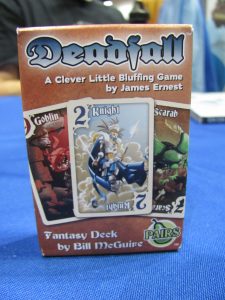 Deadfall is played as a gambling game. Players ante a coin in to the pot and throw down one card to determine who goes first. Starting with the one who played the highest card, each in turn plays a single card that’s supposed to indicate a number which they believe still remains in someone’s hand. That is, unless it’s a bluff.
Deadfall is played as a gambling game. Players ante a coin in to the pot and throw down one card to determine who goes first. Starting with the one who played the highest card, each in turn plays a single card that’s supposed to indicate a number which they believe still remains in someone’s hand. That is, unless it’s a bluff.
Alternatively, a player can challenge any other player’s last card in the round, at which point everyone reveals their remaining hands.
Between the challenger and the challenged, the person who’s correct wins the pot, as well as a penalty from the other equal to the challenged card number.
- Comments Off on Gen Con 2016—Deadfall
 Stone Blade Entertainment’s latest release for the Ascension deck-building game is War of Shadows ($40, now). This set contain light and dark cards with day and night triggers. Day is when there are more light than dark cards in the center row. Night is when there are more dark than light.
Stone Blade Entertainment’s latest release for the Ascension deck-building game is War of Shadows ($40, now). This set contain light and dark cards with day and night triggers. Day is when there are more light than dark cards in the center row. Night is when there are more dark than light.
Of a lighter theme, Stone Blade has coming up You Gotta Be Kitten Me! ($10, September). It’s a cute card game for 2-10 players with kittens and puppies wearing hats, ties, and glasses, and it plays a bit like Liar’s Dice. Around the table, players bid up a number of hats, ties, glasses, or certain color total in everyone’s hands. When challenged, if the actual count is equal to or greater than the number bid, the challenger loses and is dealt one fewer cards the next round. If the actual count is less than the number bid, the bidder loses a card. Play continues until only one player has cards left.
- Comments Off on Gen Con 2016—Stone Blade Entertainment
 A Gigamic presence at Gen Con was part of the French company’s effort to expand its presence in the U.S. market. Perhaps best known for abstract titles like Quoridor, the company also focuses on light family games, three of which it was highlighting at its first-time booth. All are available now.
A Gigamic presence at Gen Con was part of the French company’s effort to expand its presence in the U.S. market. Perhaps best known for abstract titles like Quoridor, the company also focuses on light family games, three of which it was highlighting at its first-time booth. All are available now.
Tutti Frutti ($12) is a fast-play matching game played with double-sided tokens. Each player holds a stack of tokens in hand and tries as fast as possible to match tokens on either end side-to-side with the same pictures. When all the tokens are claimed, whoever has the most is the winner.
Also a fast-play game, Panic Lab ($12) is about tracking down escaped amoebas. Cards representing laboratory features and unique amoebas—each with a distinct combination of characteristics—are placed on the table in a circle [the accompanying photo, instead of cards, shows a play mat used for demo purposes]. Then the dice are rolled and players try to be the first to point to the correct amoeba as represented by the dice. The extra-tricky part is that to figure out the correct amoeba, they have to follow a path around the circle, which as it gets to certain of those laboratory cards will modify the features they’re looking for or the direction in which they’re supposed to look.
Gloobz ($20) has players trying to be the first to grab the toy that represents either the color or shape shown the greatest or least number of times on a card. Which, greatest or least, is just whichever the players choose before flipping over the card.
- Comments Off on Gen Con 2016—Gigamic
Gen Con 2016—Iello Does Cthulhu, Sky Pirates, and Submarines
11 Aug
Posted by David Miller as Card Games, Modern Board Games
 Iello’s latest is Sea of Clouds ($30, now), a set collecting card game in which the players are sky pirates gathering treasures, artifacts, and rum. They can also pick up pirate cards, which help them in combat against their neighbors. To collect the cards, players go through a type of draft, each on their turn looking at a stack and then deciding whether to keep it or add another card at random from the draw pile and move on to the next.
Iello’s latest is Sea of Clouds ($30, now), a set collecting card game in which the players are sky pirates gathering treasures, artifacts, and rum. They can also pick up pirate cards, which help them in combat against their neighbors. To collect the cards, players go through a type of draft, each on their turn looking at a stack and then deciding whether to keep it or add another card at random from the draw pile and move on to the next.
Shipping to retail later this month are Schotten Totten ($15) and Oceanos ($40). The former is a reprint of a well-known Reiner Knizia title (also published as Battle Line) but is new to Iello. The latter was designed by Antoine Bauza and has players collecting animals and treasures from the ocean in submarines that they can upgrade with better propellers, periscopes, fish tanks, and other features.
Looking further out, Iello has planned for September Aladdin & the Magic Lamp ($25), the next in its Tales & Games series. Game-play for this 20 minute, 2-5 player title incorporates set collection and secret action selection.
October will see release of Around the World in 80 Days in a beautiful gilt slip-case. I didn’t catch much about game-play, other than it’s for 2-6 players and takes about 45 minutes.
Then in November, Iello delivers The Mysterious Forest, a cooperative memory game based on the Wormworld Saga web comic.
And sometime later comes Farm Friends, an expansion for Happy Pigs with blocky cows, sheep, and chickens; Bunny Kingdom, a card drafting, area control game by Richard Garfield; and a Cthulhu Monster Pack for King of Tokyo.
- Comments Off on Gen Con 2016—Iello Does Cthulhu, Sky Pirates, and Submarines
 A miniatures game debuting at Gen Con was Blood & Plunder from Firelock Games. One of the nice things about this one is it’s a pirate game in a historical setting. No skeletons, sea monsters, or voodoo magic. Also, the game mechanics are relatively simple, but cover both hand-to-hand and ship-to-ship combat.
A miniatures game debuting at Gen Con was Blood & Plunder from Firelock Games. One of the nice things about this one is it’s a pirate game in a historical setting. No skeletons, sea monsters, or voodoo magic. Also, the game mechanics are relatively simple, but cover both hand-to-hand and ship-to-ship combat.
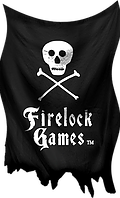 Firelock is launching Blood & Plunder in to retail with starter armies representing a variety of nationalities at $55 each. Ship models, which can carry pirate figures for boarding actions, are generic in design but available in four sizes: longboats for $12, sloops for $40, brigantines for $65, and frigates for $90.
Firelock is launching Blood & Plunder in to retail with starter armies representing a variety of nationalities at $55 each. Ship models, which can carry pirate figures for boarding actions, are generic in design but available in four sizes: longboats for $12, sloops for $40, brigantines for $65, and frigates for $90.
Firelock plans additional factions in the near future and is also contemplating expanding in to earlier and later time periods.
- Comments Off on Gen Con 2016—Blood & Plunder
Fantasy Flight to Launch RuneWars Miniatures Game
10 Aug
Posted by David Miller as Miniatures, War Games
 Announced at Gen Con, Fantasy Flight Games is entering the fantasy miniatures category with a game set in the same universe as its Runebound series. Scheduled for release in early 2017, the RuneWars Miniatures Game employs a rules system inspired by X-Wing, with template-based movement (instead of rulers) and command dials for ordering units.
Announced at Gen Con, Fantasy Flight Games is entering the fantasy miniatures category with a game set in the same universe as its Runebound series. Scheduled for release in early 2017, the RuneWars Miniatures Game employs a rules system inspired by X-Wing, with template-based movement (instead of rulers) and command dials for ordering units.
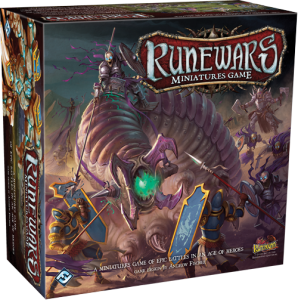 RuneWars miniatures will ship unpainted, though FFG is working with The Army Painter to develop matching paint sets.
RuneWars miniatures will ship unpainted, though FFG is working with The Army Painter to develop matching paint sets.
FFG also promised organized play support for the game.
- Comments Off on Fantasy Flight to Launch RuneWars Miniatures Game
Trending
- Massdrop.com
- Oh the Irony—Illuminati Card Game Continues to Inspire Conspiracy Theorists
- Footprints, an Educational Ecology Game
- USPS Adds Board Game Flat Rate Box
- Home
- Baila, the Estonian Drinking Card Game
- Crystal Caste Wins Dice Patent Suit Against Hasbro
- Hasbro and Mattel Merger?
- Are Board Games Dangerous?
- Board Games Based on Hindu Mythology
Archives
Most Popular Articles
- Oh the Irony—Illuminati Card Game Continues to Inspire Conspiracy Theorists
- The 20 Most Valuable Vintage Board Games
- The Truth About Dominoes On Sunday in Alabama
- Sequence Game, and Variants
- USPS Adds Board Game Flat Rate Box
- Baila, the Estonian Drinking Card Game
- The 13 Most Popular Dice Games
- Are Board Games Dangerous?
- Guess Who? The Naked Version
- What Happened to the Jewel Royale Chess Set?
Recent Posts
- Toy Fair 2019—Breaking Games
- Talisman Kingdom Hearts Edition
- Toy Fair 2019—Winning Moves
- Toy Fair 2019—Games Workshop
- Toy Fair 2019—Star Wars Lightsaber Academy
- Toy Fair 2019—Stranger Things Games
- Toy Fair 2019—HABA
- Licensing Roundup
- Game Bandit
- 2018 A Difficult Year For Hasbro But Not For D&D Or MtG
Recent Comments
- on Toy Fair 2019—Winning Moves
- on Game Bandit
- on Second Look—Dungeons & Dragons Waterdeep Dragon Heist
- on Crowdfunding Highlights
- on Beyblade SlingShock
- on Game Bandit
- on Game Bandit
- on Watch This Game!, the Board Game Review Board Game
- on Second Look—Vampire: The Masquerade 5th Edition
- on Palladium Books Loses Robotech IP License, Cancels Five-Year-Overdue Robotech RPG Tactics Kickstarter

